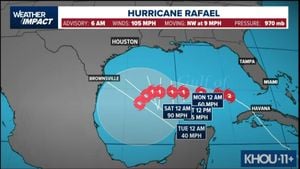On November 7, 2024, India witnessed a historic moment as President Droupadi Murmu embarked on her inaugural visit to Indian Navy ships at sea, boarding the indigenous aircraft carrier INS Vikrant. This visit not only marked her first naval excursion but also served as a significant demonstration of India’s growing maritime prowess.
Upon her arrival at the INS Hansa Naval Air Station located in Goa, President Murmu received a warm welcome from top naval officials, including Admiral Dinesh K Tripathi, the Chief of the Naval Staff, and Vice Admiral Sanjay J Singh, the Flag Officer Commanding-in-Chief of the Western Naval Command. The ceremonial greeting included a Guard of Honour comprised of 150 naval personnel, underscoring the importance of the occasion.
Once aboard INS Vikrant, which was accompanied by 15 frontline warships and submarines stationed off the coast, President Murmu was briefed on the strategic operations and capabilities of the Indian Navy. The briefing highlighted the Navy's key roles in national security and humanitarian missions, emphasizing its readiness and operational strength.
During her visit, President Murmu had the opportunity to observe several naval exercises, which showcased the capabilities of the Indian Navy. Notable demonstrations included deck-based fighter jet take-offs and landings, missile firing drills, as well as advanced submarine maneuvers. An impressive flypast featuring over 30 aircraft punctuated the event, illustrating the Navy’s diverse capabilities and readiness.
Highlighting the Indian Navy's significance, President Murmu took the occasion to acknowledge its humanitarian efforts. She particularly recalled the successful rescue operation involving the Bulgarian vessel MV Ruen, which was hijacked by pirates off the coast of Somalia. The Indian Navy's warship, INS Kolkata, undertook this high-stakes operation, during which the crew was rescued after nearly 40 hours of pursuit. Her remarks not only honored the Navy's operational reach but also reinforced its role as a protector of international maritime security.
Another pivotal aspect of her address focused on gender inclusivity within the Navy. President Murmu praised the strides made under the Agnipath Scheme, under which the Navy has become the first branch of the armed forces to formally induct women Agniveers. She celebrated the appointment of the first female commanding officer and the addition of female pilots to naval aircraft, marking progress for women in traditionally male-dominated domains.
Interaction with female Agniveers aboard INS Vikrant marked another symbolic milestone. President Murmu’s engagement with these young women signified the Navy's commitment to empowering women, reinforcing both support and leadership within the ranks, and showcasing the changing dynamics of the Indian Armed Forces.
Admiral Dinesh K Tripathi took this opportunity to highlight India's remarkable achievements in defense capability, stating, "India stands among just six nations worldwide to have established and operated both nuclear ballistic missile submarines (SSBNs) and aircraft carriers indigenously." This accomplishment reflects India's position as a growing military power and its strides toward self-reliance.
INS Vikrant, the centerpiece of this visit, is celebrated not only for its size and operational capacity but also for being the first aircraft carrier built and launched by India. Designed by the Indian Navy’s Warship Design Bureau and constructed at Cochin Shipyard Limited, INS Vikrant adds immense strategic value to India’s naval capabilities. This vessel has the potential to operate approximately 30 aircraft, including the MiG-29K fighter jets and the indigenous Light Combat Aircraft (Navy).
Around the globe, only the United States, Russia, France, the United Kingdom, and China share the distinction of designing and constructing aircraft carriers, placing India among the elite few capable of such achievements. The carrier’s impressive displacement of 43,000 tonnes when fully loaded categorizes INS Vikrant as the seventh largest among various carrier classes worldwide.
Equipped to launch and recover aircraft using the Short Take-Off but Arrested Recovery (STOBAR) method, the INS Vikrant features technology including ski-jumps to facilitate launching and arrester wires for recovery. This allows the vessel to operate seamlessly with both traditional and advanced aircraft, positioning it at the forefront of naval warfare technology.
Concluding her insightful voyage, President Murmu shared lunch with the dedicated crew of INS Vikrant, and made additional public remarks addressing the fleet at sea. She commended the Indian Navy for its unwavering dedication to protecting India's maritime interests and enhancing security within the region.
The visit aboard INS Vikrant not only highlighted the Indian Navy’s operational excellence but underscored President Murmu's commitment to enhancing national security and promoting gender inclusivity within India's armed forces. It serves as both inspiration and motivation for the future, celebrating the achievements made and the path forward for the Indian Navy. This historical visit not only reaffirmed the Navy's capabilities to the nation but also enhanced the public image of women's roles within the military sector, thereby contributing to the larger narrative of progress and empowerment.



